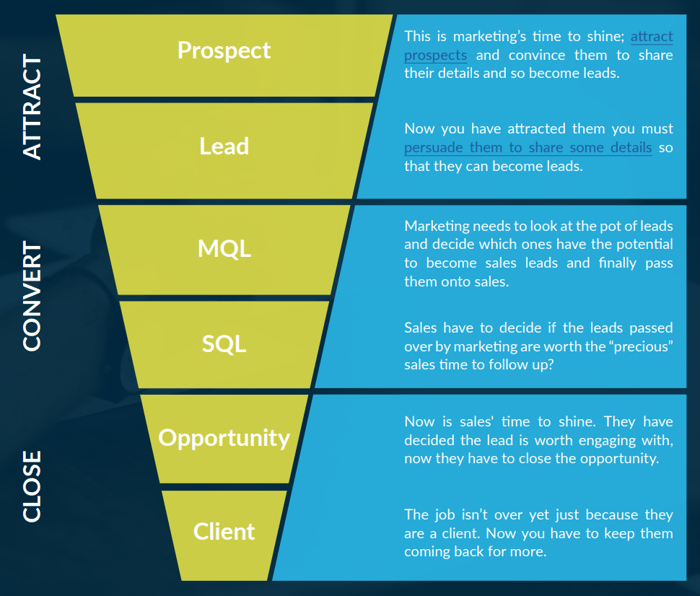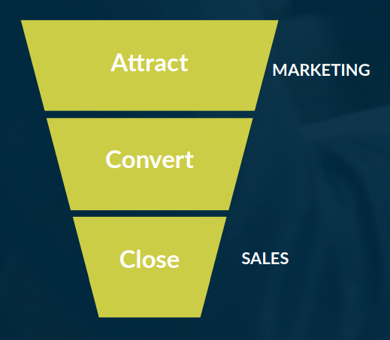Reading time: 21 minutes
What makes a lead a lead?
The days of the whisky-swilling advertising executives running marketing are over, these days all marketers must be able to demonstrate a return on investment for all their activities. Nowhere is this more relevant than with lead generation.
The digital world of marketing offers more ways than ever to generate leads but how do you sort the wheat from the chaff and make sure you can segment and qualify the leads you are generating? As important as it is to make sure that marketing and sales are aligned in their expectations of what makes up a lead, how it’s qualified and who’s responsible for following it up at each stage is just as important.
This guide aims to provide guidance on how to streamline your lead qualification and get the most from your marketing activities.
The Customer Journey:
The Buyer
To understand how a lead is first generated and then converted to a sale, you must look at the customer journey. The first way to look at it is from the customer's perspective. By understanding the journey that a customer goes through, you can understand the processes behind why some leads convert, firstly to MQLs, then into SQLs and finally into fully-fledged opportunities and sales.
Awareness
Visitor/Prospect
The potential customer starts their journey in the awareness stage. This is where they may have a problem and they are looking to find a solution. At this stage, your marketing should be aiming to attract these anonymous people and turn them into prospects through low-level soft-touch engagement such as blogs, advertising or by attracting visitors to an exhibition stand.
This is equivalent to the top, “attract” phase of the sales funnel
Consideration
Lead
After the potential customer becomes aware of your company and brand they need to know how you can solve their problems. This is known as the consideration phase of the customer journey. This is an extremely important phase, as this is where the potential customer could convert from a prospect to a lead. In order to convert to a lead, the potential customer must be willing to share
some information that will allow your company to help. But are they worthy of being an MQL?
This is equivalent to the middle, “convert” phase of the sales funnel
Decision
Client
Congratulations, your potential customer is now a lead. They are aware of what you do and that you have some solutions to their problems. They have shared some information and have had some engagement with you. Typically this is where sales take over and begin to engage directly with the lead, depending on further qualification this will deem them worthy of becoming an SQL. By the end of this stage, our customer will no longer be potential but will have either converted or been qualified out.
This is equivalent to the bottom, “close” phase of the sales funnel.
The Seller
The other way to look at the customer journey is from the seller's point of view. From the seller's perspective, you can be more objective and process-driven. The process is split into three distinct phases Attract, Convert and Close.
It is clear that for the majority of companies, the attract phase is the responsibility of marketing and the close phase is the responsibility of sales, but what about the convert phase?
This is arguably the most important phase when the buyer is still deciding if they trust and like you and your proposition. Meanwhile, you are deciding whether that potential buyer is the right fit for your proposition and therefore worth more of your attention.
We've outlined how each stage should be split out between your Sales and Marketing teams in this infographic:

MQL vs SQL: What’s the difference?
You can now understand why the convert phase is so important, but why is it so difficult?
If you were to ask a marketer and a salesperson what a lead looks like, the probability is that you would get two very different answers. There are a number of reasons for this, but at this stage, it is worth remembering that sales and marketing are responsible for very different stages of the sales funnel.
Marketing is responsible for the top of the funnel and attracting prospects whereas sales look after the bottom of the funnel and closing qualified opportunities. But how can the responsibility for the “convert” stage of the sales funnel be divided?
MQL
MQLs and SQLs are both parts of the convert phase of the sales funnel. Marketing generates leads that have the potential to become customers.
Marketing qualifies a lead by confirming:
- • They are the right type of decision-maker e.g. a marketing director.
• They are the right type of company e.g. a Technology firm with over 500 employees.
• They have engaged with the company either via online activity e.g. white paper download or via an event.
Any lead that meets these criteria can be called an MQL.
SQL
Sales want leads that have active opportunities that they can convert. Sales will scrutinise the MQLs passed over from marketing and make further enquiries to ensure they are worth being followed up by a salesperson.
Sales qualify a lead by confirming:
- • That they have the required budget.
- • That they have the authority to sign off on an order.
- • That they have a need for the proposition e.g. it isn't just a whim.
- • That the propositions timescale is realistic.
- • That they have the right attitude towards the company and the proposition.
This is called BANTA qualification and when carried out properly will ensure that there is a genuine opportunity present for the sales team. Any lead that meets these criteria can be called an SQL.
How and when to qualify a lead
When marketing generates a lead they need to qualify it as an MQL. This means measuring two key parameters; Fit and Interest.
Fit
Fit is how well-suited the lead is to the business. To measure whether a business is a good fit for you, you need to get a lead to share the following information via a web form or in a conversation:
- • Their Name
• Their Contact Details
• Their Job Role/Position
• Company Name
Interest
Interest is how engaged a lead is with your business. To measure if a lead is engaged with your business you need to track the points of engagement (in order to track some of these you will need some form of
marketing automation software):
- • Website visits
- • Content downloads
• Conversations
• Email Clicks (not opens as these can be misleading)

When you have measured both fit and interest, you can then plot them against what you know makes a good lead for your business.
If they meet the minimum criteria that you set, they are an MQL e.g. IT director in a retail company with over 500 employees who have visited the website 5 times in the last month and downloaded a whitepaper.
The table below provides some suggested timescales for the different results. It is important to follow up on any MQLs which are both a good fit and have shown interest as quickly as possible as most buyers (60%) will go with the company that contacts them first!
| Result | Action Required | Timescale |
|
Qualified Out |
Leave alone for now but check back a few months later to see if the situation has changed. |
6 months |
| Nurture | These leads need a little more encouragement. Nurture them using personalised content to increase the interest in your services. |
2 weeks - 3 months |
| More Qualification Required | Need to confirm if the company is a good fit. Need to be qualified by phone either by sales or marketing. |
1 - 3 days |
| MQL | Pass to sales as soon as possible so they can be converted to an SQL! |
24 hours |
Just because a lead has been qualified out doesn’t mean you can discard it. Circumstances change, businesses make money and then want to invest therefore it is worth checking in with that lead in a few months' time.
The right level of service
The convert phase of the sales funnel can be difficult and it’s easy to understand why. This is the traditional cross-over stage between sales and marketing, where marketing passes on the leads that they have qualified based on one set of criteria to sales who will qualify again based on another set; you can see where the confusion arises! How can you stop this confusion?!
"Marketing are passing on loads of MQLs and complain that sales aren’t following them up quickly enough."
"Sales say that there are too many irrelevant MQLs that take too much time to follow up."
The answer? The Service Level Agreement or SLA for short. This is a written document that formalises the professional relationship between sales and marketing. It needs to be jointly written and signed off by both heads of department. It will not be easy but it is worth it!
Here is a list of topics that all sales and marketing service level agreements should address:
- • Shared Objectives
What are the shared objectives for both sales and marketing to meet and how will they be measured and reported to both sales and marketing? E.g. Profit, return on investment or revenue? - • What is an MQL?
What are the minimum qualification criteria for an MQL? E.g. IT director in a retail company with over 500 employees who have visited the website 5 times in the last month and downloaded a whitepaper. - •Who follows up on an MQL?
Which specific person or team is responsible for looking at and following up MQLs? It could be the Sales Director or it could be an internal sales team? - • How many follow-up attempts are made per MQL?
How many attempts are made to follow up the MQL before it is qualified out? E.g. 3 phone calls and an email? - • How are MQLs followed up and how quickly?
Will the MQLs be called or emailed or both? What timescales are applied to the follow up of an MQL? E.g. First attempt to be made within 24 hours. - • What is an SQL?
When does an MQL become an SQL? Is it when it is accepted by sales or when it has further qualifications applied to it, how much time will this take per lead? E.g. Budget, Authority, Need, Timescale and Attitude? Make sure to differentiate between an SQL and an Opportunity. - • Feedback Mechanism
When an MQL is accepted/qualified as an SQL what happens next e.g. what is the sales process and how will feedback about lead quality, type of company/contact be fed back to marketing to improve lead generation? - • Lead Nurture Process
For MQLs that are a good fit but are either rejected by sales for lack of interest or that don’t quite make the MQL grade who is responsible for nurturing them and how will they do it? - • What does success look like?
How are you going to meet the shared objectives? What does success look like in terms of numbers? E.g. MQLs > SQLs > Opportunities > Customers?
The best way to work out what success looks like, is to take the shared sales and marketing objective which is normally revenue-based and work backwards to determine the number of SQLs, MQLs, Leads and Prospects.
- Customers
- How many customers do you need to meet your shared objective? Start by working out your average order size. Divide the revenue target by the average order size to get the number of orders you require. E.g. If your average order was £10,000 and the revenue target was £100,000 it would be £100,000/£10,0000 = 10 orders and assuming 1 order per customer = 10 customers.
- Opportunities
- The next step is to work out how many opportunities you need to get those customers. You can work that out from your conversion rate. E.g. How many customers did you quote compared to how many customers actually bought? If your conversation rate was 50% we would need 20 opportunities to get 10 customers.
- SQLs
- How many SQLs are realistic opportunities? To put it another way how many serious (non-qualification) conversations do your sales team have compared to the number of eventual quotes (opportunities)? You will need to base this number on your definition of an SQL and how much qualification it will go through. E.g. If you quoted on every other conversation you have with an SQL (1 in every 2) in this example you would need 40 SQLs.
- MQLs
- Now the interesting part! How many MQLs do you need to produce the number of SQLs you need? Remember this number will need to be based on your definition of what constitutes an MQL. If you have specified a well-qualified MQL then fewer of them will be qualified out by sales. E.g. If 3 out of every 4 MQLs is qualified out this would mean that in this example you would need 160 MQLs.
- Leads
- To work out the number of leads you require to generate the MQLs, you need to know how many of the enquires (including content downloads) you receive either online or otherwise are the right fit as defined by your MQL definition? E.g. for every 10 people that fill out an online form only 1 of them is a decision-maker at the right sort of company, then in this example, you would need 1,600 leads.
- Prospects
- The easiest way to work out the number of prospects is to look at the visitors to your website over a quarter and look at how many of them submitted enquiries or filled out lead forms. E.g. If 1 in 5 people who visit your website complete a form then in this example you would need to attract 8000 prospects or visitors.
It is worth remembering that despite what sales sometimes claim, they are only human and only have so much time in the day. This has a direct impact on the number of MQLs and SQLs that they can follow up on.
Therefore when working out what success looks like and planning how many MQLs you can generate, you will also need to ask sales the question “how many SQLs can your team process in reality?"
How an MQL turns into an SQL
Turning MQLs into SQLs can seem a little bit like black magic but it is possible by following a
structured approach and getting marketing and sales bought into the same formalised process.
Here’s what to remember…
- • To turn an MQL into an SQL you need to understand the customer journey from both the buyer's and the seller's points of view.
- • Sales and marketing are responsible for different areas of the sales funnel and this, in turn, affects what they are looking for in a lead. Marketing is looking to attract as many of the right types of leads as possible. Sales are looking for leads that have viable opportunities.
- • An MQL is a lead that is qualified by marketing and is assessed to make sure it is the right fit and has some interest in your business.
- • An SQL is an MQL that has been accepted by sales as being worthy of follow-up by a member of the sales team.
- • The convert stage is the joint responsibility of sales and marketing as this is where a potential buyer transitions from a lead to an MQL, from an MQL to an SQL and from an SQL into an Opportunity.
- • An SLA is the best way to ensure that the central convert phase of the sales funnel is carried out effectively.
- • An SLA only works if sales and marketing have a shared objective e.g. based on revenue.
- • An SLA formalises how many MQLs and SQLs are required, how they are qualified and who is responsible for what.
- • You can work out the number of MQLs and SQLs required to meet the objective by working backwards.
How can GCL help?
GCL is a B2B marketing services provider specialising in Telemarketing, Data and Research. With over 30 years’ experience in unscripted and multilingual call services, we specialise in engaging with prospects, leads and MQLs on your behalf. Our expert team can generate new prospects, increase interest through a structured nurture process, and qualify leads so that only quality contacts are passed over to your team, ready to be followed up.








